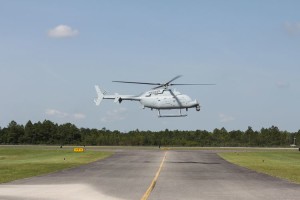The Navy recently started flight tests of the MQ-8C Fire Scout unmanned helicopter with the Leonardo AN/ZPY-8 radar.
Flight testing began Feb. 27 but builder Northrop Grumman [NOC] disclosed the testing on May 8. The AN/ZPY-8 is a version of Leonardo’s Osprey X-band active electronically scanned array (AESA) radar.

“The AN/ZPY-8 radar significantly increases Fire Scout’s detection and tracking of targets. The ability to simultaneously employ multiple modes supports U.S. Navy intelligence, surveillance and reconnaissance requirements,” Melissa Packwood, Northrop Grumman program manager for tactical autonomous systems, said in a statement.
“This increased capability enables Fire Scout to extend ranges to meet emerging requirements,” she added.
In testing, the aircraft operated out of Webster Outlying Field near Naval Air Station Patuxent River, Md.
The company said testing started with several weeks of ground testing before the first flight and continues now “as the Navy and Northrop Grumman consider mission expansion opportunities for the platform.”
The Fire Scout uses a Bell [TXT] 407 airframe and is a larger and longer endurance variant of the MQ-8B. It can operate for up to 12 hours on station, depending on payload.
The Navy intends to deploy the MQ-8Cs with Littoral Combat Ships for reconnaissance, situational awareness, and precision targeting support and complement the MH-60 manned helicopter to extend the range of ship-based operations.
Northrop Grumman has thus far delivered 32 of 38 MQ-8Cs ordered to the Navy and the company said all of them will be retrofitted with the radar.
The MQ-8C reached initial operational capability last June and is scheduled for its first deployment in 2021 (Defense Daily, July 8, 2019).